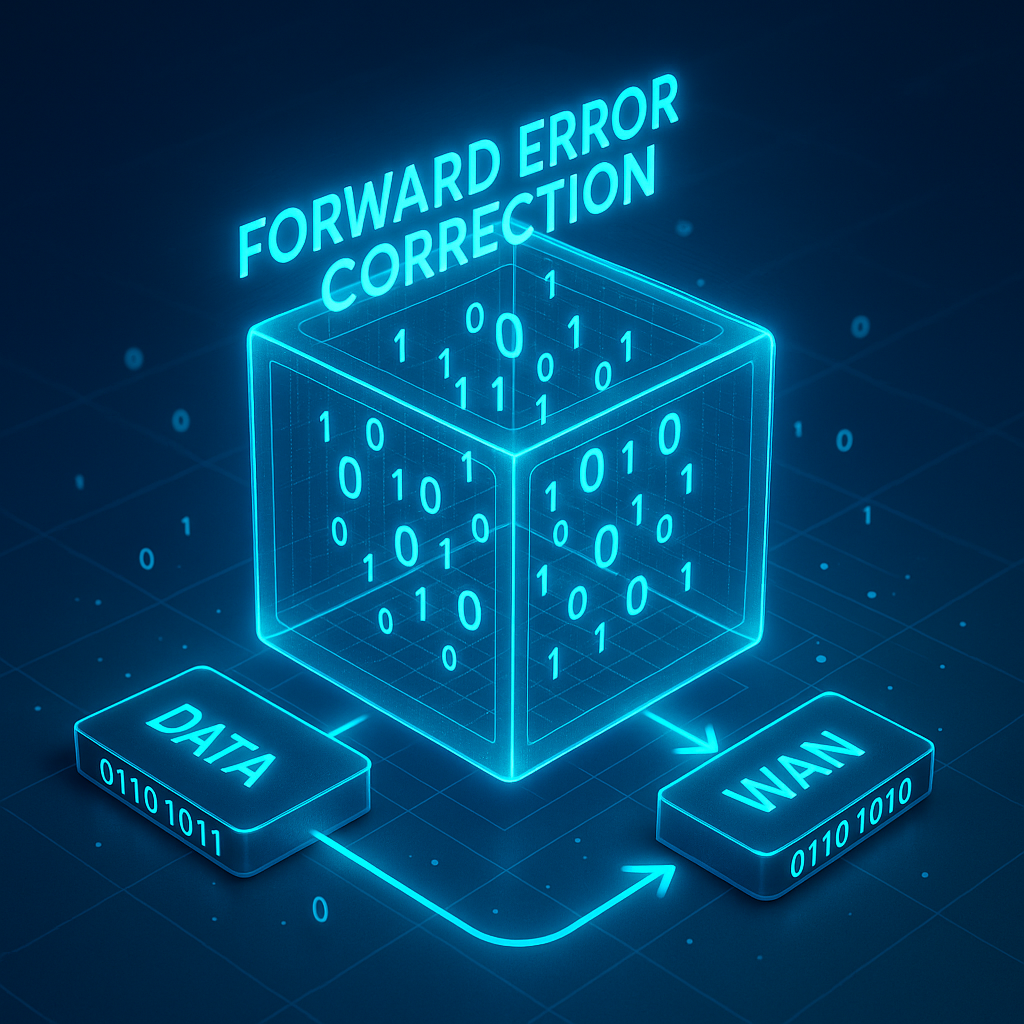When you’re working with wide area networks (WANs), there’s a constant enemy you’ll face—data loss. Whether it’s caused by long distances, weak links, or congested traffic, losing packets during transmission is frustrating and costly. That’s where forward error correction (FEC) steps in. Think of it as your network’s safety net. Rather than waiting for corrupted data to be resent, FEC fixes errors on the fly, making your network faster and more efficient.
Forward error correction (FEC) is a vital technique used in WAN optimization to fix data errors before they slow down your network. It helps maintain the integrity of data as it travels across unstable or high-latency connections, like satellite links or long-distance corporate WANs. No more laggy video calls or buffering streams—FEC makes real-time communication reliable and smooth.
In this guide, you’ll learn what forward error correction is, how it works, where it’s used, and why it’s essential for WAN performance. Buckle up—this could be the missing puzzle piece to your network problems.
Key Takeaways
- Forward error correction helps fix corrupted data without retransmitting.
- It’s used in WANs to reduce latency and improve performance.
- Popular FEC types include Reed-Solomon, Hamming, and LDPC.
- It’s especially useful in lossy or high-latency networks like satellite and VoIP.
- FEC is part of many WAN optimization solutions.
What is Forward Error Correction?
Forward error correction is a method that lets the receiving system detect and correct data errors without needing the sender to resend the data. Instead of simply sending raw information, FEC systems transmit extra bits known as “redundant data.” These bits help the receiver reconstruct the original data, even if some parts were corrupted in transit.
The concept stems from the brilliant mind of Claude Shannon, often referred to as the father of information theory. His work showed that it’s possible to ensure reliable communication over noisy channels—like those used in WANs—by using redundancy wisely.
Unlike ARQ (Automatic Repeat reQuest), which involves detecting errors and asking the sender to retransmit, FEC takes a proactive approach. It’s faster and more efficient, especially in high-latency environments where retransmissions are expensive or slow. This is exactly why it’s become so critical for optimizing WAN performance.
Think of it like spell check for your emails. Even if you make a typo, your software can often guess what you meant and fix it automatically. FEC works in a similar way—it’s constantly guessing and correcting, ensuring your data gets through cleanly.
In the world of WAN optimization, FEC plays a crucial role. By minimizing the need for retransmissions, it ensures smoother data flow, faster loading times, and a better user experience—especially when connections are shaky or long-distance.
How Forward Error Correction Works
At its core, FEC is all about smart redundancy. Here’s how it works: when data is sent across a network, it’s broken into packets. With FEC, each packet includes not only the original data but also extra information—parity bits—that help detect and fix errors on the receiving side.
Imagine sending the word “HELLO” across a shaky connection. With FEC, you might also send some additional data like a checksum or encoded version of the word. If “HELLO” becomes “HEXXO” due to transmission noise, the receiver uses the redundant bits to figure out what the original message was supposed to be.
Let’s break it down in a step-by-step example using binary:
- Original Data: 1011001
- Encoding: Add parity bits based on mathematical formulas.
- Transmission: The combined code (original + parity) is sent.
- Error Occurs: One or more bits flip due to noise (e.g., 1010001).
- Decoding: Receiver checks the parity, detects an error, and corrects it.
- Output: Corrects it back to 1011001 without asking for a resend.
This self-healing data magic happens thanks to algorithms that have evolved over decades. From simple parity checks to complex codes like LDPC (Low-Density Parity Check), FEC methods vary in complexity and power.
To make this relatable, think of FEC as having autocorrect for your digital messages. Just like your phone fixes a typo before you even notice it, FEC does the same for your data—silently correcting mistakes and keeping your network fast and frustration-free.
Why Forward Error Correction Matters in WAN Optimization
Let’s face it: WAN connections are not perfect. They’re often plagued with high latency, packet loss, and jitter. Whether you’re dealing with cloud applications, VoIP, or remote desktop sessions, errors in transmission are bound to happen. That’s why forward error correction is a game-changer.
Unlike traditional methods like ARQ that require retransmissions—which eat up time and bandwidth—FEC avoids the back-and-forth by fixing issues right then and there. This makes your WAN connection feel snappier and more stable, even if the actual link is far from ideal.
For real-time applications like video conferencing or VoIP, this is priceless. A dropped frame or garbled word can ruin an important call. FEC helps smooth out those hiccups by ensuring packets arrive clean, or at least corrected, before they ever reach your ears or eyes.
FEC also shines in satellite communication, where sending data back and forth isn’t just slow—it’s expensive. Reducing the need for retransmissions saves money and improves user experience.
Here’s a kicker: many WAN optimization tools from vendors like Riverbed or Silver Peak integrate FEC under the hood. You might not see it, but it’s working tirelessly to keep your network clean and responsive. These tools often include SSH key management, compression, deduplication, and other advanced features to secure and speed up data transmission.
By using FEC, these solutions minimize packet loss, improve throughput, and deliver a seamless experience across even the most unreliable networks. So the next time someone asks you what is WAN optimization, tell them it’s part smart routing, part acceleration—and a whole lot of error correction.
Types of Forward Error Correction Codes
The magic of FEC lies in the error correction codes. These are the mathematical frameworks that make recovery possible. Let’s explore the most common types and where they shine:
Hamming Code
This is the classic FEC method you’ll find in textbooks. Developed by Richard Hamming, it corrects single-bit errors and detects double-bit errors. Simple and elegant, Hamming codes are often used in older or embedded systems, where resources are limited but basic protection is needed.
It works by placing parity bits at specific locations in your data and using binary math to figure out which bit, if any, has flipped.
Reed-Solomon Code
If Hamming is a bike, Reed-Solomon is a jet. It can correct burst errors, which occur when several bits in a row get corrupted—a common problem in optical media, satellite links, and even QR codes.
NASA used this in space missions, and it’s still widely used today. It’s especially good for environments with high noise or interference.
Convolutional Codes
These work in continuous streams, rather than blocks. Ideal for real-time audio and video, they use current and past bits to encode the stream, which helps in consistent data recovery.
You’ll find them in streaming devices, Bluetooth, and voice communication systems.
Turbo Codes
A more modern and powerful solution, Turbo codes are often used in cellular networks, especially in 3G and 4G systems. They provide near-optimal error correction with moderate computational demand.
They work by iterating decoding steps, bouncing guesses between two or more decoders to refine the results.
LDPC (Low-Density Parity-Check) Codes
The current gold standard, LDPC codes are incredibly powerful and efficient. They’re used in Wi-Fi, 5G, and digital broadcasting. With roots in Shannon’s early theories, they were rediscovered in the ’90s and are now crucial to high-speed, low-latency systems.
LDPC uses a sparse matrix approach that allows massive parallelization, making it ideal for modern hardware acceleration.
FEC vs ARQ: What’s the Difference?
In the realm of network communication, two primary methods ensure data integrity: Forward Error Correction (FEC) and Automatic Repeat reQuest (ARQ). Both serve the purpose of correcting errors, but their approaches are vastly different, and choosing the right one can make or break your network’s performance.
Here’s the core distinction: FEC corrects errors at the receiver without requesting retransmissions, while ARQ detects errors and asks the sender to retransmit corrupted packets. This fundamental difference influences everything from latency to bandwidth efficiency.
Let’s visualize it through a quick table:
Feature | FEC | ARQ |
Retransmission | Not needed | Required if errors found |
Latency | Low | Higher due to resend delays |
Best for | Unreliable, high-latency links | Reliable, low-latency links |
Used in | WANs, VoIP, Satellites | TCP/IP, LANs, Stable Networks |
FEC is the go-to for real-time applications like voice, video, or satellite communication where waiting for a resend is impractical. Imagine you’re on a Zoom call and your voice drops for a second. With FEC, that packet gets corrected on the fly. With ARQ, your words might arrive too late to be useful.
ARQ, on the other hand, is more common in environments where reliability outweighs speed, such as file downloads over TCP/IP. If you’re downloading a large PDF, you’d rather it take an extra second than receive a corrupted version.
Many systems combine both FEC and ARQ for hybrid reliability. For instance, your home Wi-Fi might use FEC for streaming video but switch to ARQ when downloading an update.
Knowing when to use FEC vs ARQ comes down to your priorities: real-time performance or absolute data integrity. In most WAN scenarios—especially where packet loss or jitter is an issue—FEC wins the race hands down.
Real-World Applications of Forward Error Correction
Forward error correction isn’t just a theoretical concept—it’s embedded in the backbone of modern communication technologies. Let’s look at how various industries and use cases rely on FEC to function smoothly and deliver consistent performance.
Satellite Communication
FEC is essential in space and satellite systems. Why? Because resending data 22,000 miles up and back (in geostationary orbit) introduces huge delays. Organizations like NASA, SpaceX, and Starlink rely heavily on FEC to ensure data from space probes or satellite relays arrives intact the first time.
Streaming Services
You know that moment when Netflix buffers and ruins your binge session? That’s what FEC helps prevent. Services like Netflix, YouTube, and Spotify use FEC to compensate for inconsistent internet connections. By correcting errors in real-time, FEC reduces buffering and keeps audio/video quality consistent, especially in low-bandwidth situations.
VoIP and Real-Time Calls
In Voice over IP (VoIP) systems, FEC plays a pivotal role. A dropped packet here means a lost syllable or awkward silence. FEC allows platforms like Zoom, Skype, and Teams to deliver smooth audio without relying on retransmission delays. Some systems use “interleaving” with FEC to further enhance voice quality.
Cellular Networks (4G, 5G)
Modern wireless systems are noisy environments. 4G and 5G networks use advanced FEC codes like Turbo and LDPC to maintain high throughput and data fidelity. With the rise of IoT and smart cities, FEC ensures sensors, cameras, and mobile devices stay connected despite interference.
Data Storage (DVDs, SSDs)
It’s not just about transmission—FEC is also used in data storage. Devices like DVDs, Blu-rays, and solid-state drives (SSDs) embed Reed-Solomon or LDPC codes to recover data even if part of the media is scratched or corrupted.
In short, FEC is the invisible guardian that keeps your favorite apps, files, and devices working flawlessly in the face of errors.
Common Tools and Technologies That Use FEC
You might not realize it, but forward error correction is already working behind the scenes in many of the tools and platforms you rely on daily—especially those dealing with high-performance networking or sensitive data transmission.
WAN Accelerators
Leading WAN optimization appliances like Riverbed SteelHead, Silver Peak Unity EdgeConnect, and Cisco WAAS implement FEC as a core component. These devices sit between your network endpoints and actively analyze, compress, and correct traffic in real time.
By applying FEC, they can avoid packet retransmission, reducing latency and improving overall throughput—especially helpful for global enterprises operating across continents.
VPNs Over Lossy Networks
VPNs help secure data, but they often struggle with performance over long distances. Adding FEC into the VPN stack—especially in SSL/TLS tunnels—helps counteract the negative effects of packet loss and improves stability.
SD-WAN Solutions
Modern Software-Defined WANs (SD-WAN) often come with built-in FEC mechanisms. Vendors like Cisco, Fortinet, and VMware Velocloud use FEC to improve voice and video performance over broadband or LTE links, making these virtual networks just as reliable as dedicated lines.
Hardware Support
Routers and switches from manufacturers like Juniper, Arista, and Huawei often include FEC chipsets or firmware support, particularly for high-speed optical links and fiber backbones. This allows data centers to transmit huge volumes of data with minimal error rates.
These tools demonstrate just how embedded FEC has become in the modern digital infrastructure. From secure connections to high-speed transfers, FEC is everywhere—even if you can’t see it.
Benefits and Drawbacks of Forward Error Correction
Like any technology, forward error correction has its pros and cons. Knowing both sides can help you decide if and when to implement it in your network stack.
Benefits
- No Need for Retransmissions: FEC saves time and bandwidth by correcting errors on the receiver’s end without needing to ask the sender to resend data.
- Improves Real-Time Performance: From VoIP calls to video conferencing, FEC keeps things smooth by avoiding delays that disrupt conversations.
- Better Throughput in Lossy Environments: Especially in WANs, satellite links, and mobile networks, FEC helps maintain consistent performance.
- Enables Predictable Quality of Service (QoS): IT admins can better manage SLAs and ensure minimum performance levels, even when networks misbehave.
Drawbacks
- Bandwidth Overhead: The redundancy that makes FEC work also consumes more bandwidth. This can be an issue on very constrained networks.
- Increased Processing Demand: Encoding and decoding FEC data requires CPU cycles, which could tax low-powered devices like IoT sensors.
- Not Foolproof: In extremely poor conditions, FEC might not correct all errors—especially if too many bits are corrupted.
Overall, the benefits far outweigh the drawbacks, especially when dealing with modern WAN environments or real-time communication protocols.
As FEC becomes a core part of WAN and networking discussions, many questions naturally arise. Let’s clear up some of the most common concerns and curiosities surrounding this powerful technology.
What is the purpose of forward error correction?
At its heart, forward error correction is all about reliability without delay. It allows a receiver to detect and correct transmission errors on the fly, using redundant data embedded in the original transmission. This eliminates the need to ask the sender to resend corrupted packets—a huge win for real-time communications, such as voice, video, or satellite data.
Whether you’re streaming a movie, joining a video call, or transferring critical files across a WAN, FEC ensures the data arrives intact, even across unreliable or long-distance networks.
Is FEC used in all WAN optimization tools?
Not every WAN optimization solution includes FEC, but many of the high-end or enterprise-grade platforms do. Tools from companies like Riverbed, Silver Peak, and Cisco integrate FEC into their optimization stacks alongside compression, deduplication, traffic shaping, and SSH key management.
It’s especially prevalent in setups that demand real-time reliability—think SD-WAN, VoIP, and remote access across international sites.
Does FEC slow down the network?
While it may seem like adding extra data for redundancy would slow things down, the opposite is typically true. FEC prevents retransmissions, which means data doesn’t have to be sent multiple times. The added overhead is minimal compared to the latency you save.
In environments where latency is high or packet loss is frequent, FEC can dramatically improve perceived speed and responsiveness.
What’s the difference between forward and backward error correction?
- Forward error correction happens entirely at the receiver’s end, using embedded redundancy to fix problems.
- Backward error correction, like ARQ, requires the receiver to detect errors and then request a retransmission from the sender.
FEC is proactive and best for real-time systems; ARQ is reactive and ideal when accuracy is more important than immediacy.
Which FEC code is best?
There’s no one-size-fits-all answer here. Each FEC code is optimized for specific use cases:
- Reed-Solomon is excellent for burst errors (e.g., satellite, DVD).
- LDPC is the go-to for modern, high-speed systems like 5G and Wi-Fi.
- Hamming codes are perfect for simple, single-bit error correction in older or embedded systems.
- Turbo codes shine in mobile communications under noisy conditions.
- Convolutional codes are preferred in streaming data and voice traffic.
Your choice depends on the application, network conditions, and performance requirements.
Conclusion
To sum it all up: Forward error correction is one of the most crucial technologies quietly powering the digital world. Whether you’re video conferencing, streaming a movie, making a VoIP call, or controlling a satellite thousands of miles away, FEC ensures the data gets through clearly and reliably—without delay, without repeat.
In the context of WAN optimization, FEC proves its worth every single day. It reduces latency, boosts throughput, and enhances user experience in environments that were once considered unreliable or slow. It works hand-in-hand with other optimization techniques like traffic shaping, deduplication, and secure SSH key transfers, forming a holistic solution for fast, resilient connectivity.
Understanding what is forward error correction and how it integrates with what is WAN optimization gives you a clearer view of how modern networks achieve such reliability—even over long distances or lossy media.
So, next time you’re watching Netflix, attending a virtual meeting, or syncing massive files across continents—remember the unsung hero in the background: forward error correction.





